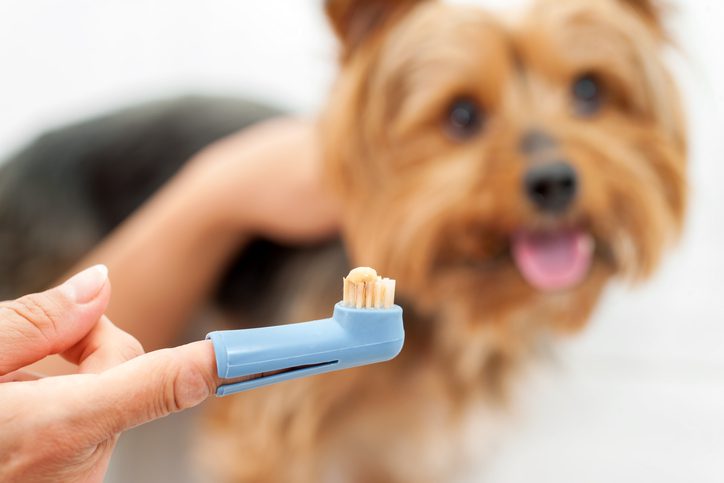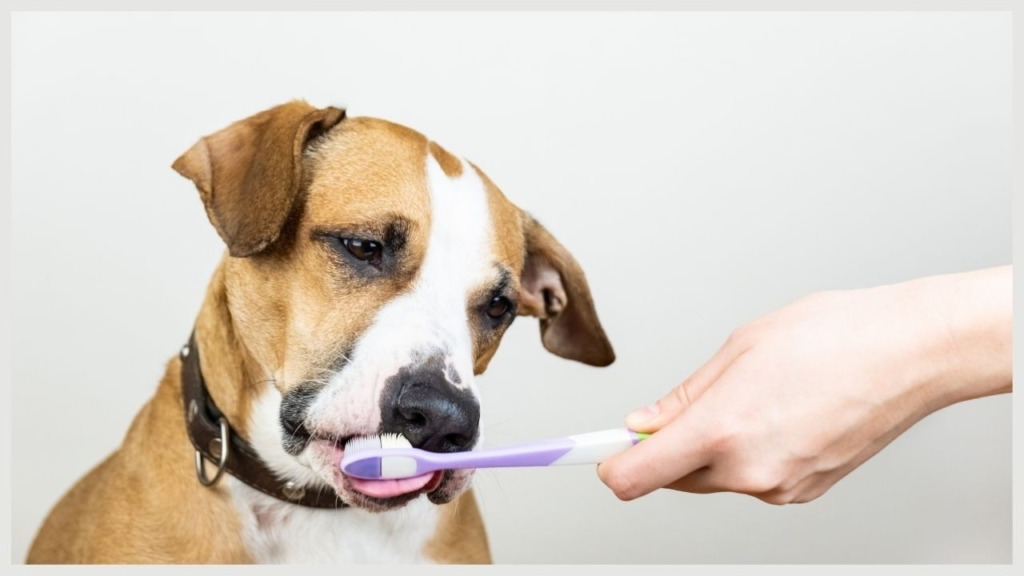Dog Finger Toothbrush

Dog Finger Toothbrush:- Dogs need dental care just like humans do. Regular tooth brushing plays a crucial role in maintaining oral health and preventing dental diseases like plaque, tartar buildup, tooth decay, and gingivitis. Without proper brushing, plaque accumulates on a dog’s teeth, leading to a host of problems, such as halitosis (bad breath), periodontal disease, and even bacterial infections that can affect other parts of the body.
The importance of this routine cannot be understated, as consistent brushing helps stave off expensive and potentially harmful dental treatments down the line.

Dr. Lindon Simon, a veterinary surgeon, emphasized to *The Spruce Pets* how essential brushing is for a dog’s dental care: “Brushing your dog’s teeth is the best thing you can do to prevent dental disease as they get older. It is more important than diet and has much more of an effect than any powder or liquid you can add to their food or water. Brushing their teeth will almost certainly prevent them from needing expensive dental treatments down the line.”
Choosing the Right Dog Finger Toothbrush for Your Dog
The most effective Dog Finger Toothbrush is one that you are comfortable using regularly and that suits your dog’s mouth. Ideally, the toothbrush should be easy to hold, appropriately sized for your dog’s mouth, and equipped with soft bristles that won’t irritate the gums. While there are various types of toothbrushes available, from finger brushes to traditional brushes, the key is finding one that both you and your dog are comfortable with.
What Is a Dog Finger Toothbrush for Dogs?
Finger toothbrushes are popular among pet owners, especially for those with smaller dogs or for beginners to dog brushing. These brushes are made from soft silicone and fit snugly over your finger, giving you control and ease when cleaning your dog’s teeth. The soft bristles are gentle on your dog’s gums, making it easier to reach all areas of the mouth without causing discomfort.
Pros of Finger Toothbrushes:
1. Ease of Use: The design offers greater control, making it easier to clean hard-to-reach areas.
2. Comfort for the Dog: The soft bristles are gentle on sensitive gums, which makes brushing less stressful for your dog.
3. Compact Design: Small and easy to carry, finger toothbrushes are great for travel or dogs skittish about larger brushes.
Cons of Finger Toothbrushes:
1. Limited Reach: It can be difficult to clean back molars effectively, especially for larger dogs.
2. Durability: Finger toothbrushes wear out faster due to the softness of the bristles.

Testing Finger Toothbrushes
Here’s a quick look at some popular finger toothbrushes based on their ease of use and comfort for dogs:
– Silicone Finger Brush (Molain): All dogs tolerated this brush. The brush was easy to use but had soft, short bristles that might not get all the plaque around the edges of the teeth.
– Silicone Bristle Finger Toothbrush (Boshel): While tolerable to all dogs, this brush was bulky, and its stiff bristles made it harder to maneuver in smaller dogs’ mouths.
– Nylon Bristle Finger Toothbrush (Boshel): This brush featured soft bristles and maneuvered well around the teeth but was too tall to easily reach the back teeth in smaller dogs.
– Child-Sized Soft Bristle Toothbrush: Tolerable to all dogs tested, this brush had soft bristles and could easily reach the back of the mouth, making it a great option for small dogs.
– Silicone 360-Degree Cat Toothbrush: While all dogs tolerated this brush, its wide round head made it difficult to clean under the lip, and the bristles weren’t as effective at cleaning between teeth.
– 3-Sided Pet Toothbrush and 360-Degree Dog Toothbrush: These brushes required more handling, and the dogs were less interested in them. They weren’t ideal for use due to their size and complexity.
Building a Dog Brushing Routine
If you’re new to brushing your dog’s teeth, it’s important to ease into the process to build a positive association with brushing. Regularity and patience are key to establishing an effective brushing routine. Ideally, you’ll start when your dog is still a puppy, but even if you start later in life, you can still build a successful brushing regimen.
1. Start Slow: Begin by letting your dog lick toothpaste off your finger to get accustomed to the taste.
2. Introduce the Toothbrush: Allow your dog to lick the paste off the toothbrush before you attempt brushing.
3. Brush Gradually: After a few days, try gently running the brush over their teeth for short sessions—around 30 seconds to start.
4. Praise and Reward: Throughout the process, reward your dog to create a positive association with brushing.
By breaking the process into small, manageable steps, you’re more likely to gain your dog’s cooperation and make brushing a regular part of their routine. Dr. Gary Richter, DVM, author of *The Ultimate Pet Health Guide*, recommends starting dental care early: “It’s best to begin when a puppy is between 8 and 12 weeks of age; however, it’s never too late.” He also points out that the brushing process can be a bonding activity: “The daily brushing process should be pleasant for both you and your pet, as it’s a moment of closeness between the two of you.”

Step-by-Step Guide to Brushing Your Dog’s Teeth
1. Begin with Comfort: Gently pet and scratch your dog’s muzzle, slowly lifting their lip for about 30 seconds. Praise and offer a treat afterward.
2. Familiarize with Teeth Touching: Repeat the process, but this time, gently run your finger over your dog’s teeth for 20-30 seconds.
3. Introduce Toothpaste: Put a small amount of toothpaste on the brush and let your dog lick it off. If they don’t like the flavor, try a different one.
4. Start Brushing: Once your dog is comfortable, begin brushing, focusing on the upper outer surfaces for 20-30 seconds on each side.
If your dog is resistant, be patient. Some dogs may take a few weeks to become fully comfortable with the process.
Why Brushing Matters?
Oral health is directly connected to overall health in dogs. Just like in humans, brushing helps prevent tooth loss, gingivitis, and other dental issues. Plaque, the thin film on the teeth, can accumulate over time due to food and saliva. If not brushed away, plaque hardens into tartar, which can lead to periodontal disease.
Periodontal disease can cause significant pain and inflammation, affecting not only the teeth but the gums, ligaments, and jawbone. Worse yet, bacteria from inflamed gums can enter the bloodstream, potentially leading to infections in vital organs like the heart and kidneys.
By brushing daily, you can help prevent the progression of plaque into tartar and keep your dog’s overall health in check. It’s a small routine that can make a significant difference in your pet’s life.
Also Read:-




